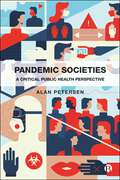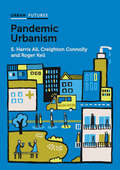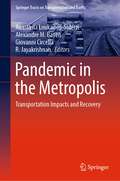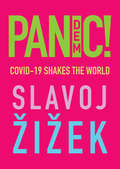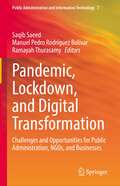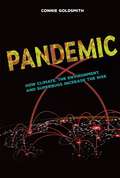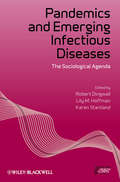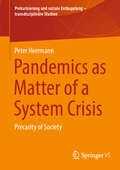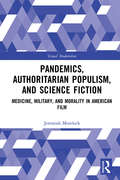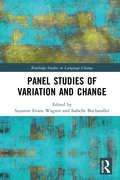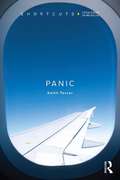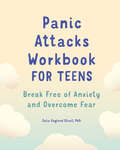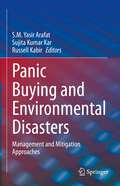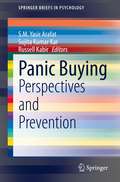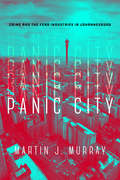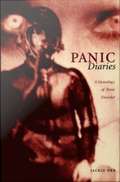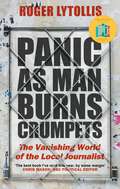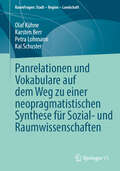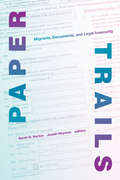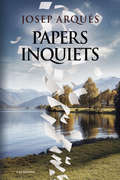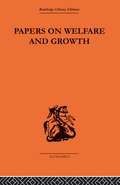- Table View
- List View
Pandemic Societies: A Critical Public Health Perspective
by Alan PetersenFrom SARS to Zika, and Ebola to COVID-19, epidemics and pandemics have become increasingly prevalent in recent years. Each outbreak presents new challenges but the responses are often similar. This important book explores the dimensions, dynamics and implications of emerging pandemic societies. Drawing on ideas from sociology and science and technology studies, it sheds new light on how pandemics are socially produced and, in turn, shape societies in areas such as governance, work and recreation, science and technology, education, and family life. It offers pointers to the future of pandemic societies, including the expansion of technologies of surveillance and control, as well as the prospects of social renewal created by economic and social disruption.
Pandemic Urbanism: Infectious Diseases on a Planet of Cities (Urban Futures Series)
by Roger Keil S. Harris Ali Creighton Connolly<p>Emerging infectious disease outbreaks have transformed the very nature of urban life worldwide, even as the extent and experience of pandemics are shaped by the planetary urban condition. Pandemic Urbanism critically investigates these relationships in a world faced with its first pandemic on a majority urban planet.<p> <p>The authors reveal the social and historical context of recent infectious disease events and how they have variously transformed the urban fabric. They highlight the important role played by socio-ecological processes associated with the global urban periphery – suburban or post-suburban zones and hinterland areas of “extended” urbanization – changing mobility patterns, and new forms of urban governance and pandemic response. The book develops novel insights for post-pandemic urban governance and planning grounded in the quest for social and spatial justice. In doing so, it reveals a paradox at the heart of pandemic urbanism: urban life enables contagion to spread easily, yet at the same time offers unique possibilities to contain and respond to disease outbreaks.<p>
Pandemic in the Metropolis: Transportation Impacts and Recovery (Springer Tracts on Transportation and Traffic #20)
by Anastasia Loukaitou-Sideris Alexandre M. Bayen Giovanni Circella R. JayakrishnanThis book brings together reports of original empirical studies which explore the impacts of the COVID-19 pandemic on urban mobility and transportation and the associated policy responses. Focusing on the California region, the book draws on this local experience to formulate general lessons for other regions and metropolitan areas. The book examines how the COVID-19 pandemic has had different impacts on vulnerable populations in cities. It explores the pandemic's impacts on the transportation industry, in particular public transit, but also on other industries and economic interests that rely on transportation, such as freight trucking, retail and food industries, and the gig-economy. It investigates the effect of the viral outbreak on automobile traffic and associated air quality and traffic safety, as well as on alternative forms of work, shopping, and travel which have developed to accommodate the conditions it has forced on society. With quantitative data supported with illustrations and graphs, transportation professionals, policymakers and students can use this book to learn about policies and strategies that may instigate positive change in urban transport in the post-pandemic period.
Pandemic!: COVID-19 Shakes the World
by Slavoj iekAs an unprecedented global pandemic sweeps the planet, who better than the supercharged Slovenian philosopher Slavoj i ek to uncover its deeper meanings, marvel at its mind-boggling paradoxes and speculate on the profundity of its consequences? We live in a moment when the greatest act of love is to stay distant from the object of your affection. When governments renowned for ruthless cuts in public spending can suddenly conjure up trillions. When toilet paper becomes a commodity as precious as diamonds. And when, according to i ek, a new form of communism – the outlines of which can already be seen in the very heartlands of neoliberalism – may be the only way of averting a descent into global barbarism. Written with his customary brio and love of analogies in popular culture (Quentin Tarantino and H. G. Wells sit next to Hegel and Marx), i ek provides a concise and provocative snapshot of the crisis as it widens, engulfing us all.
Pandemic, Lockdown, and Digital Transformation: Challenges and Opportunities for Public Administration, NGOs, and Businesses (Public Administration and Information Technology #7)
by Saqib Saeed Manuel Pedro Rodríguez Bolívar Ramayah ThurasamyThis edited volume discusses digital transformation in the context of the COVID-19 pandemic. In the wake of the COVID-19 pandemic and the widespread lockdown policies that followed, digital technologies were touted as an effective means towards ensuring continuity and minimal interruption of day-to-day operations for businesses and other institutions. Digital transformation, however, is an inherently complex process and the pressure of short adoption times may further increase complexities for organizations looking to foster digital technologies. This volume comprises original research contributions on theoretical foundations and empirical studies of digital transformations in the pandemic era. Written by academics and practitioners from diverse disciplines and industries, the chapters cover topics such as psychological and technical implications of pandemic situations, the economic, organizational, social, and legal implications of digital adoption, and case studies for digital transformation in different industries. This book will be useful for academics, technology professionals, business policy makers, NGO managers, and governments looking to optimize their digital transformation processes to better prepare their organizations in the presence of pandemic situations.
Pandemic: How Climate, the Environment, and Superbugs Increase the Risk
by Connie GoldsmithThroughout history, several deadly pandemics brought humanity to its knees, killing millions, and recent outbreaks of Ebola and Zika took coordinated international efforts to prevent them from spreading. Learn about factors that contribute to the spread of disease by examining past pandemics and epidemics, including the Bubonic Plague, smallpox Ebola, HIV/AIDS, and Zika. Examine case studies of potential pandemic diseases, like SARS and cholera, and find out how pathogens and antibiotics work. See how human activities such as global air travel and the disruption of animal habitats contribute to the risk of a new pandemic. And discover how scientists are striving to contain and control the spread of disease, both locally and globally.
Pandemics and Emerging Infectious Diseases: The Sociological Agenda (Sociology of Health and Illness Monographs)
by Karen Staniland Lily M. Hoffman Robert DingwallInfectious disease pandemics are a rising threat in our globalizing world. This agenda-setting collection provides international analysis of the pressing sociological concerns they confront us with, from cross-border coordination of public health governance to geopolitical issues of development and social equity. Focuses on vital sociological issues raised by resurgent disease pandemics Detailed analysis of case studies as well as broader, systemic factors Contributions from North America, Europe and Asia provide international perspective Bold, agenda-setting treatment of a high-profile topic
Pandemics as Matter of a System Crisis: Precarity of Society (Prekarisierung und soziale Entkopplung – transdisziplinäre Studien)
by Peter HerrmannPandemics — it seems that it had been the beginning of a new era, after a first shock wave a new normality commenced trying to, repress the complex challenges while living under a new Sword of Damocles. Origins and consequences of the virus had been frequently issued, but only little attention had been paid to structural problems of societies, making it difficult to cope with the exceptional situation. The present book, focusing on the German polity and its structural weakness, analysis the situation in a historical perspective. It is completed by an essayist globalist outlook on the pandemics.The provocative thesis is that the precarity of society is itself a kind of virus, in many ways as dangerous as the Corona virus. The latter one showed the weak – and dangerous – points of the failure of the polity that need urgent and thorough political answers.
Pandemics, Authoritarian Populism, and Science Fiction: Medicine, Military, and Morality in American Film (Visual Modernities)
by Jeremiah MorelockWith a focus on I Am Legend and Day of the Dead—two series of film remakes of popular science fiction stories—this book addresses the social origins of the recent surge in authoritarian and populist social movements. Exploring the ways in which the themes of tribalism, confidence in medical science, and confidence in military violence changed over the years in the process of re-telling these stories in popular culture, the author identifies the shift towards a narrowing of moral scope, an embrace of military violence and a distrust of medical science with three elements of authoritarian populism: tribalism, distrust of rational elites and their institutions, and willingness for violent coercion. An engaging study of popular culture that sheds light on contemporary political attitudes, Pandemics, Authoritarian Populism, and Science Fiction will appeal to scholars of sociology, social theory, and cultural studies with interests in critical theory, film studies, and science fiction.
Pandemie im Film: Religiöse und ästhetische Transformationen in der Populärkultur (pop.religion: lebensstil – kultur – theologie)
by Harald Schroeter-Wittke Inge KirsnerUntersucht wird die theologische und ästhetische Bearbeitung der Pandemien in dystopischen und Science-Fiction-Filmen sowie Serien. Zwischen Verschwörungstheorien, der Sicht als Strafe Gottes und der fatalistischen Annahme eines "notwenigen Übels" changieren die Erklärungsmodelle im Film wie auch in der gesellschaftlichen Wirklichkeit. Filme bieten dabei stellvertretend narrative Lösungsmodelle an. Die Katastrophe wird auf diese Weise dem beängstigenden Alltag für kurze Zeit enthoben, was eine der Reflexion zuträgliche Distanz ermöglicht. Exemplarisch wird ein sich wandelndes Rollen-, Gesellschafts- und Gottesbild aufgezeigt, das zu religionspädagogischen Reflexionen anregt.
Pandemisches Virus – nationales Handeln: Covid-19 und die europäische Idee (Räume – Grenzen – Hybriditäten)
by Dominik Brodowski Florian Weber Jonas NesselhaufDie Covid-19-Pandemie fordert die europäische Idee heraus: Denn nicht nur die EU-Außengrenzen, sondern auch Binnengrenzen innerhalb des Schengen-Raums wurden ab Frühjahr 2020 wieder verstärkt kontrolliert, durch an deren Überquerung anknüpfende Quarantäne- und Test-Vorschriften zum Hindernis oder auch zeitweise ganz geschlossen. Damit sind die geographischen Grenzverläufe für Berufspendelnde, für Ausflügler:innen oder für Einkaufende wieder ,real‘. Doch reichen die Auswirkungen über Transit, Tourismus und Handel weit hinaus: Mit den verstärkten Kontrollen, Quarantänepflichten und Schließungen verändert sich auch die Wirkung der territorialen Grenz(ziehung)en. Das betrifft schließlich auch die grenzüberschreitende Zusammenarbeit in binneneuropäischen Grenzregionen. Im Zusammenspiel aus Kultur-, Raum- und Rechtswissenschaften erfolgt im Sammelband eine multiperspektivisch vertiefende Beleuchtung zu Covid-19 und der europäischen Idee.
Panel Studies of Variation and Change (Routledge Studies in Language Change)
by Isabelle Buchstaller Suzanne Evans WagnerThe relationship between the individual and the community is at the core of sociolinguistic theorizing. To date, most longitudinal research has been conducted on the basis of trend studies, such as replications of cross-sectional studies, or comparisons between present-day cross-sectional data and ‘legacy’ data. While the past few years have seen an increasing interest in panel research, much of this work has been published in a variety of formats and languages and is thus not easily accessible. This edited volume brings together the major researchers in the field of panel research, highlighting connections and convergences across and between chapters, methods and findings with the aim of initiating a dialogue about best practices and ways forward in sociolinguistic panel studies. By providing, for the first time, a platform for key research on panel data in one coherent edition, this volume aims to shape the agenda in this increasingly vibrant field of research.
Panic (Shortcuts)
by Keith TesterImpending environmental catastrophe, threat of terrorism, viruses both biological and virtual, disease: there seem to be so many reasons to panic today. But what is panic and why does it happen? This book uses a range of literature from sociology, cultural studies and popular psychology to develop an original analysis of panic in contemporary social life. Bringing together academic literature from a range of disciplines, films, novels and current affairs, it encourages thought about why and how we panic – both individually and collectively. Keith Tester explores how cataclysmic events and smaller-scale episodes expose the fragility of our relationships, institutions and expectations. He shows how thinking about panic reveals key aspects of contemporary social, cultural and personal relationships. Panic is a highly readable and incisive introduction to the subject for students, scholars and all those who want to know what panic means and why it is important.
Panic Attacks Workbook for Teens: Break Free of Anxiety and Overcome Fear
by Julia Englund Strait PhDConquer panic attacks with therapy-based strategies for teens Dealing with anxiety and panic attacks on top of school, friends, and thoughts of the future can make it hard to be a teenager. The Panic Attacks Workbook for Teens helps you better handle panic attacks with exercises and explanations that make it easier for you to face your fears and get back to the things you love. Interactive activities and prompts encourage you to experiment with different ways of responding to tough experiences. You'll explore how panic affects your brain and body, then practice mental and physical strategies—like controlling your breathing and identifying your panic triggers—that help you tackle panic head-on. The basics of panic attacks—Learn about what panic attacks are and why they happen, as well as how the tools in this workbook can help you understand, predict, and manage them. Answers to common questions—Explore questions from other teens about common scenarios where panic might arise, and get detailed responses that show you how to handle them. Real therapy techniques—Discover strategies taken from evidence-based recovery methods, such as cognitive behavioral therapy, exposure therapy, mindfulness, and positive psychology. Get the practical tools you need to recognize and overcome panic attacks so you can live your life to the fullest.
Panic Buying and Environmental Disasters: Management and Mitigation Approaches
by S. M. Yasir Arafat Sujita Kumar Kar Russell KabirPanic buying is a common response during crises; however, to date it has been a significantly under-researched area. Recent evidence suggests that an environmental stimulus, such as the COVID-19 pandemic, war, earthquakes, flooding, public health emergencies (SARS, MARS) can trigger this phenomenon. As an environmental crisis takes its toll, the understanding of panic buying becomes overlooked. Nevertheless, panic buying causes series of events separate from these primary events. Understanding the management of emergencies and disasters should be an integral part of dealing with panic buying since every major environmental crisis has the potential to initiate panic buying behaviour in the general public. This book will analyse episodes of panic buying and major environmental crisis focusing on specific prevention strategies. This book is the first of its kind of approach to join up the management of panic buying during a public health emergency.
Panic Buying: Perspectives and Prevention (SpringerBriefs in Psychology)
by S. M. Yasir Arafat Sujita Kumar Kar Russell KabirThis brief provides a thorough overview of the history and underlying motivations for consumer panic buying, evaluating psychological perspectives on this behavior on both an individual and societal level. The first volume of its kind to focus specifically on the topic of panic buying, the book situates its analysis within the context of the modern COVID-19 pandemic as well as in a broader psychology context. Chapters encompass a variety of interdisciplinary perspectives, incorporating insights from consumer psychology, marketing, sociology, and public health. Finally, contributors discuss the long-term implications of panic buying and potential prevention strategies. Panic Buying: Perspectives and Prevention will be a useful reference for researchers and students in consumer psychology, as well as those interested emergency preparedness, and supply chain management. First volume of its kind to focus specifically on the consumer behavior of panic buyingAnalyzes panic buying behavior in the context of the modern COVID-19 pandemic as well as within a broader psychology contextProvides a multidisciplinary analysis of panic buying, including perspectives from consumer psychology, social psychology, marketing, emergency preparedness, and public health.
Panic City: Crime and the Fear Industries in Johannesburg
by Martin J. MurrayDespite the end of white minority rule and the transition to parliamentary democracy, Johannesburg remains haunted by its tortured history of racial segregation and burdened by enduring inequalities in income, opportunities for stable work, and access to decent housing. Under these circumstances, Johannesburg has become one of the most dangerous cities in the world, where the yawning gap between the 'haves' and 'have-nots' has fueled a turn toward redistribution through crime. While wealthy residents have retreated into heavily fortified gated communities and upscale security estates, the less affluent have sought refuge in retrofitting their private homes into safe houses, closing off public streets, and hiring the services of private security companies to protect their suburban neighborhoods. Panic City is an exploration of urban fear and its impact on the city's evolving siege architecture, the transformation of policing, and obsession with security that has fueled unprecedented private consumption of 'protection services.' Martin Murray analyzes the symbiotic relationship between public law enforcement agencies, private security companies, and neighborhood associations, wherein buyers and sellers of security have reinvented ways of maintaining outdated segregation practices that define the urban poor as suspects.
Panic Diaries: A Genealogy of Panic Disorder
by Jackie OrrPart cultural history, part sociological critique, and part literary performance, Panic Diaries explores the technological and social construction of individual and collective panic. Jackie Orr looks at instances of panic and its "cures" in the twentieth-century United States: from the mass hysteria following the 1938 radio broadcast of H. G. Wells's War of the Worlds to an individual woman swallowing a pill to control the "panic disorder" officially recognized by the American Psychiatric Association in 1980. Against a backdrop of Cold War anxieties over atomic attack, Orr highlights the entanglements of knowledge and power in efforts to reconceive panic and its prevention as problems in communication and information feedback. Throughout, she reveals the shifting techniques of power and social engineering underlying the ways that scientific and social scientific discourses--including crowd psychology, Cold War cybernetics, and contemporary psychiatry--have rendered panic an object of technoscientific management. Orr, who has experienced panic attacks herself, kept a diary of her participation as a research subject in clinical trials for the Upjohn Company's anti-anxiety drug Xanax. This "panic diary" grounds her study and suggests the complexity of her desire to track the diffusion and regulation of panic in U. S. society. Orr's historical research, theoretical reflections, and biographical narrative combine in this remarkable and compelling genealogy, which documents the manipulation of panic by the media, the social sciences and psychiatry, the U. S. military and government, and transnational drug companies.
Panic as Man Burns Crumpets: The Vanishing World of the Local Journalist
by Roger Lytollis'For those who know about provincial newspapers, this will be a classic and a gem. Those who don't know will envy what they have missed' MELVYN BRAGG'Brisk and entertaining. A very readable love letter to a disappearing world, told with verve and tenderness' STUART MACONIE, author of Pies and Prejudice'Gut-bustingly funny, poignant and packed with astonishing insider information'M. W. CRAVEN, author of the award-winning The Puppet ShowYou dreamed of being a journalist and the dream has come true. You love working for your local paper . . . although not everything is as you imagined.You embarrass yourself with a range of celebrities, from John Hurt to Jordan. Your best story is 'The Man With the Pigeon Tattoo'.A former colleague interviews President Trump. You urinate in the president of the Mothers' Union's garden. Your appearance as a hard-hitting columnist on a BBC talk show does not go well. And being photographed naked is only the second most humiliating thing to happen one infamous afternoon. There are serious stories, such as a mass shooting, a devastating flood, and the search for Madeleine McCann.Meanwhile local papers are dying. Your building is crumbling and your readership is dwindling. Your carefully crafted features are read by fewer people than a story about fancy dress for dogs. Panic as Man Burns Crumpets is the inside story of local newspapers during the past twenty-five years, told in a way that's funny, poignant and revealing.
Panic as Man Burns Crumpets: The Vanishing World of the Local Journalist
by Roger Lytollis'For those who know about provincial newspapers, this will be a classic and a gem. Those who don't know will envy what they have missed' MELVYN BRAGG'Brisk and entertaining. A very readable love letter to a disappearing world, told with verve and tenderness' STUART MACONIE, author of Pies and Prejudice'Gut-bustingly funny, poignant and packed with astonishing insider information'M. W. CRAVEN, author of the award-winning The Puppet Show'Local journalism has never seemed more exotic than in this part-memoir, part-ode to that disappearing art, which is as funny as it is endearing . . . Told with a tender fondness, the bonkers, baffling but vital world of local press is paraded with the style that it deserves'JONATHAN WHITELAW, Sun'Refreshingly honest, engagingly self-deprecating, tremendously funny and more than a little heartbreaking. By far my favourite read of the year so far'MIKE WARD, TV editor, Daily Express/Daily Star 'Local publishers . . . need to hold on to thoughtful, dedicated writers such as Roger Lytollis, or his book will be an epitaph to a centuries-old industry'IAN BURRELL, i paper'Anyone who has ever worked at a local newspaper, or wondered what it is like, should read this book'DOMINIC PONSFORD, media editor at New Statesman Media Group/editor-in-chief at Press Gazette'[Lytollis] writes with clarity, comically self-effacing honesty and surprising poignancy . . . [this is] the story of what it is like to love what you do, and be great at it, and to watch it collapse around you in slow motion' ROBYN VINTER, GuardianYou dreamed of being a journalist and the dream has come true. You love working for your local paper . . . although not everything is as you imagined.You embarrass yourself with a range of celebrities, from John Hurt to Jordan. Your best story is 'The Man With the Pigeon Tattoo'.A former colleague interviews President Trump. You urinate in the president of the Mothers' Union's garden. Your appearance as a hard-hitting columnist on a BBC talk show does not go well. And being photographed naked is only the second most humiliating thing to happen one infamous afternoon. There are serious stories, such as a mass shooting, a devastating flood, and the search for Madeleine McCann.Meanwhile local papers are dying. Your building is crumbling and your readership is dwindling. Your carefully crafted features are read by fewer people than a story about fancy dress for dogs. Panic as Man Burns Crumpets is the inside story of local newspapers during the past twenty-five years, told in a way that's funny, poignant and revealing.
Panorama of the Pandemic: A Phenomenological Inquiry (Academics, Politics and Society in the Post-Covid World)
by Simi Malhotra Ruchi Nagpal Steven S. George Sananda RoyThis volume provides a multi-nuanced analysis of the impact of the Covid-19 pandemic on various aspects of human existence, encompassing societal, economic, and inter-relational dimensions. It highlights a broad range of artistic and literary experiences that unfolded as a consequence of the pandemic or speak to that time.The book revisits pandemic-induced shifts, phenomenologically, including the digitization of art and representations of creativity, “performance” anxiety, socio-political climate determined by “racial algorithms,” gaming surges, employment insecurities, mental health issues from a pedagogical materiality, and the nature of apocalypse through literary reimaginations. It also delves into the global food crisis, reframing of family structures, and local subjectivities as lived experiences.A unique contribution, the book will be useful for students and researchers of cultural studies, digital humanities, mass media, sociology, mental health, psychology, medical anthropology, public health, literature, history of pandemics and epidemics, and South Asian studies.
Panrelationen und Vokabulare auf dem Weg zu einer neopragmatistischen Synthese für Sozial- und Raumwissenschaften (RaumFragen: Stadt – Region – Landschaft)
by Olaf Kühne Karsten Berr Kai Schuster Petra LohmannDieses Buch führt den Neopragmatismus als innovativen theoretischen Rahmen für Sozial- und Raumwissenschaften ein. Jenseits essenzialistischer Wahrheitsansprüche und stabiler Subjekt-Objekt-Dichotomien bewegt sich der hier präsentierte Ansatz bewusst jenseits klassischer Theoriegegensätze. Im Zentrum des Buches steht eine Operationalisierung von Richard Rortys Vokabulartheorie und panrelationalistischem Ansatz für die Sozial- und Raumwissenschaften. Welt als ein dynamisches, instabiles Netz von Relationen verstanden, das mittels Vokabularen sprachlich umrissen wird. Diese Perspektive wird durch die Einbindung von Diskurstheorien, Konflikttheorien sowie der Akteur-Netzwerk-Theorie weiter differenziert. Mit der Verbindung von Sprachtheorie, Metatheorie und Panrelationalismus werden Raumkategorien wie Landschaft, Region oder Stadt, als kontingente und konfliktbehaftete Konstruktionen begriffen. In Fallbeispielen zur Biographiekonstruktion und zu Landschaftskonflikten wird der entwickelte Ansatz einer Prüfung unterzogen. Darin wird die Komplexität sozialer und räumlicher Phänomene mittels des entwickelten Ansatzes erfasst und für eine gesellschaftliche Problembefassung fruchtbar gemacht. Das Buch richtet sich an Personen, deren Interesse an theoretischen Abstraktionen und zugleich praktisch anschlussfähigen Perspektiven auf Gesellschaft und Raum gerichtet ist. Sei es in der Soziologie, Philosophie, Geographie, Politikwissenschaft oder interdisziplinären Feldern der Befassung in dem Themenfeld Gesellschaft und Raum.
Paper Trails: Migrants, Documents, and Legal Insecurity (Global Insecurities)
by Sarah B. Horton Josiah HeymanAcross the globe, states have long aimed to control the movement of people, identify their citizens, and restrict noncitizens' rights through official identification documents. Although states are now less likely to grant permanent legal status, they are increasingly issuing new temporary and provisional legal statuses to migrants. Meanwhile, the need for migrants to apply for frequent renewals subjects them to more intensive state surveillance. The contributors to Paper Trails examine how these new developments change migrants' relationship to state, local, and foreign bureaucracies. The contributors analyze, among other toics, immigration policies in the United Kingdom, the issuing of driver's licenses in Arizona and New Mexico, the Deferred Action for Childhood Arrivals program, and community know-your-rights campaigns. By demonstrating how migrants are inscribed into official bureaucratic systems through the issuance of identification documents, the contributors open up new ways to understand how states exert their power and how migrants must navigate new systems of governance.Contributors. Bridget Anderson, Deborah A. Boehm, Susan Bibler Coutin, Ruth Gomberg-Muñoz, Sarah B. Horton, Josiah Heyman, Cecilia Menjívar, Juan Thomas Ordóñez, Doris Marie Provine, Nandita Sharma, Monica Varsanyi
Papers Inquiets
by Josep ArquésPensament pel debat sobre temes actuals. Una mirada lúcida i, a voltes, volgudament polèmica sobre temes actuals com l'ansietat social, el feminisme, la fragilitat de l'enamorament, l'art avantguardista i la moda. <P><P>Sense refusar qüestions eternes, com la bellesa, l'amistat, la mort i la religió. Vint-i-vuit breus assaigs, que l'autor anomena «papers», i que inclouen desassossecs personals sobre els singulars continguts del discdur de la nostra ment o sobre la difícil conjuntura del nostre país. <P><P>El text conté referències i opinions de grans autors que han influït decisivament en el pensament occidental i està escrit amb un estil clar, sobri i concís.
Papers on Welfare and Growth
by Tibor ScitovskyThe volume is divided into three parts:A: Economic Growth and Related Problems (covering international trade and economic integration, including a comparative study between Europe and America)B: Theoretical Welfare Economics (welfare propositions in economics, profit maximization and its implications and the Theory of Tariffs)C: Practical Welfare Economics (the price of economic progress, equity and international payments).
